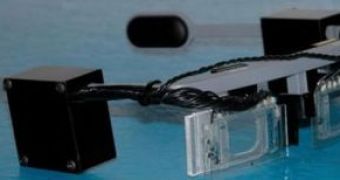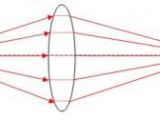In up to five years they could be commercialized: a new type of glasses with a switch - when you need to look at close objects you turn the glasses on, when you want to look at distant objects you turn them off.
Optical scientists Guoqiang Li and Nasser Peyghambarian of the University of Arizona in Tucson and colleagues have developed a prototype that uses liquid crystals to change focus in an instant, preventing the eye strain induced by wearing conventional bifocal glasses. Focusing through specific portions of a bifocal lens causes many users to become dizzy or disoriented, while others report increased eye fatigue.
"Bifocals effectively work the same way they have since they were invented by Benjamin Franklin," says Peyghambarian. "But as any of more than 40 million people in America who need bifocals know, they're a pain."
The new lens consists of a layer of material known as a liquid crystal, which is sandwiched between two thin sheets of glass. The inner surfaces of the glass sheets are covered with circular transparent electrodes arranged in a bulls eye pattern. Applying a voltage to one of these electrodes affects the speed with which light can pass through that part of device. So, why does this work?
How do lenses work?
Light doesn't always travel in straight lines; it travels on that particular path that takes the least amount of time to reach from A to B. If the medium through which it passes is homogenous, than the path that takes the least time is the straight line. However, if the medium is not homogenous and light travels with different speeds through some parts of that medium, than the resulting path, the path that takes the least amount of time, is curved in some way.
Light travels slower through glass than through air, so, for example, if you want to get a bunch of light rays emerging from a light source (A) to converge in a single point (B), than you have to make all these rays to take the same amount of time to reach from A to B. The light traveling on the shortest paths will have to be forced to take longer time to reach from A to B; therefore, these shorter rays are passed through a thicker layer of glass (that slows the light). The light traveling on the longest rays will be passed trough the thinner layer of glass. This is why a glass lens that focuses the light is made thicker in the middle and thinner at the edges. Conversely, if you want a divergent lens that spreads the light rays instead of focusing them, you have to make it thinner in the middle and thicker at the edges.
Correcting the eye
Now, of course, we have a convergent lens in our eye. This lens is flexible and if we want to look at distant objects the lens flattens a little. If we want to focus on close objects the lens bumps a little. The light coming from the observed object has to be focused exactly on the retina - otherwise you get a blurred image. However, what happens is that when people get older, the flexibility of these eye lenses diminishes and the lenses cannot properly get into the bumpier shape needed for seeing close objects. The remedy is to place a pair of convergent lenses in front of the eyes, in order to compensate. (In case of nearsighted people the opposite is necessary - one needs divergent lenses for correction.)
The new technology
The new type of lens uses the exact same optical principle as the glass lenses, but slows down the light in a different way. Instead of slowing it down more by passing it through a thicker sheet of glass, it slows it down by electrically modifying the quality of the transparent material. The lenses are flat. But the liquid crystals in the middle are electrically controlled to let the light pass slower through them, while the liquid crystals at the edges are controlled to allow the light to go faster. Not only can these glasses change from on to off but they can also change gradually.
So, simply by applying the voltages, they could switch the device from either a transparent plate or a lens for distant vision to a lens for close vision. "When it's on it has focusing power that can be used for reading," said Li in an interview. "When it's off, it has no focusing power - it's just like a piece of glass - and can be used for driving and seeing far off things."
Compared to bifocals, the advantage of this new technology is that you get a full field of view correction.
Photo credit: Prototype of adaptive eyeglasses - PNAS. Imaging using electroactive diffractive lens with a model eye. Image is out of focus with corrective lens off (left), but clear with lens on (right). Credit: PNAS

 14 DAY TRIAL //
14 DAY TRIAL // 


